国际经济学试题
(完整)国际经济学考试题库(答案版)
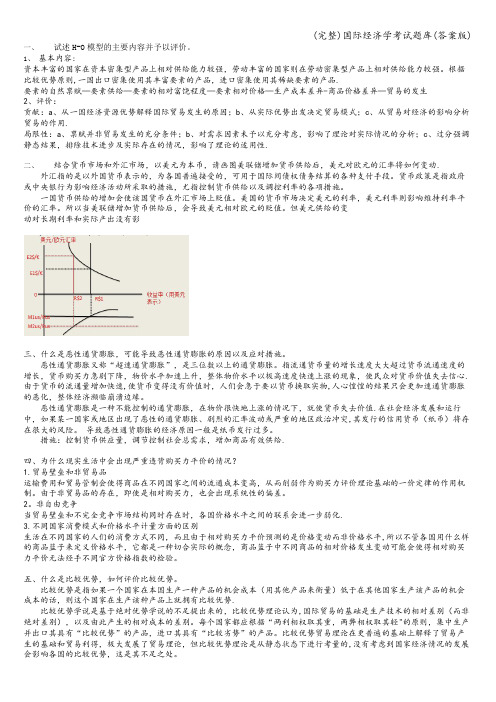
一、试述H-O模型的主要内容并予以评价。
1、基本内容:资本丰富的国家在资本密集型产品上相对供给能力较强,劳动丰富的国家则在劳动密集型产品上相对供给能力较强。
根据比较优势原则,一国出口密集使用其丰富要素的产品,进口密集使用其稀缺要素的产品.要素的自然禀赋—要素供给—要素的相对富饶程度—要素相对价格—生产成本差异-商品价格差异—贸易的发生2、评价:贡献:a、从一国经济资源优势解释国际贸易发生的原因;b、从实际优势出发决定贸易模式;c、从贸易对经济的影响分析贸易的作用.局限性:a、禀赋并非贸易发生的充分条件;b、对需求因素未予以充分考虑,影响了理论对实际情况的分析;c、过分强调静态结果,排除技术进步及实际存在的情况,影响了理论的适用性.二、结合货币市场和外汇市场,以美元为本币,请画图美联储增加货币供给后,美元对欧元的汇率将如何变动.外汇指的是以外国货币表示的,为各国普遍接受的,可用于国际间债权债务结算的各种支付手段。
货币政策是指政府或中央银行为影响经济活动所采取的措施,尤指控制货币供给以及调控利率的各项措施。
一国货币供给的增加会使该国货币在外汇市场上贬值。
美国的货币市场决定美元的利率,美元利率则影响维持利率平价的汇率。
所以当美联储增加货币供给后,会导致美元相对欧元的贬值。
但美元供给的变动对长期利率和实际产出没有影三、什么是恶性通货膨胀,可能导致恶性通货膨胀的原因以及应对措施。
恶性通货膨胀又称“超速通货膨胀”,是三位数以上的通货膨胀。
指流通货币量的增长速度大大超过货币流通速度的增长,货币购买力急剧下降,物价水平加速上升,整体物价水平以极高速度快速上涨的现象,使民众对货币价值失去信心.由于货币的流通量增加快速,使货币变得没有价值时,人们会急于要以货币换取实物,人心惶惶的结果只会更加速通货膨胀的恶化,整体经济濒临崩溃边缘。
恶性通货膨胀是一种不能控制的通货膨胀,在物价很快地上涨的情况下,就使货币失去价值.在社会经济发展和运行中,如果某一国家或地区出现了恶性的通货膨胀、剧烈的汇率波动或严重的地区政治冲突,其发行的信用货币(纸币)将存在很大的风险。
国际经济学试题_精选稿(教师用-含部分答案)_

国际经济学精选习题集第一部分国际贸易理论第1章绪论一、单项选择题1.国际经济学在研究资源配置时,划分的基本经济单位是(D)A.企业B.个人C.政府D.国家2.国际经济学研究的对象是(B)A.国际商品流动B.世界范围内的稀缺资源的最优配置C.国际收支平衡D.国际人员流动3.从国际间经济资源流动的难易度看,流动最容易的是(B)A.商品B.资本C.人员D.技术二、判断分析题1.国际经济学是建立在微观经济学与宏观经济学基础之上的一门分支科学。
√。
大部分国际经济学应用了宏微观经济学的一般原理,如无差异曲线、需求曲线、企业产量按照MR=MC确定等,但是国际经济学理论本身也获得了许多理论性的进步。
在此基础上的国际经济学研究又推动了一般经济学理论研究方法的发展。
第2章比较优势原理一、单项选择题1.比较优势理论认为,国际贸易的驱动力是(A)。
A.劳动生产率的差异B.技术水平的差异C.产品品质的差异D.价格的差异2.从15世纪初到18世纪中叶,在国际贸易和国际收支理论方面占主导地位的是(A)。
A.重商主义B.重农主义C.重金主义D.自由放任主义3.绝对成本学说是比较成本学说的(C)。
A.同一形式B.发展形式C.特殊形式D.理论形式4.亚当·斯密的绝对优势理论认为(C)。
A.所有产品均具有绝对优势的国家最终将获得全部黄金和白银B.具有绝对优势的国家将获得大量贸易余额C.如果两个国家分别出口本国劳动成本相对较低的产品,将同时从贸易中获益D.如果一国不用关税壁垒保护本国产业将丧失绝对优势5.李嘉图比较优势理论指出(B)。
A.贸易导致不完全专业化B.即使一个国家不具备绝对成本优势,也可从出口绝对成本劣势相对较小的产品中获益C.与不具备绝对成本优势的国家相比,具有绝对成本优势的国家可以从贸易中获利更多D.只有具备计较优势的国家才能获得贸易余额6.根据比较成本说,一国从国际贸易中获益的条件是(B)。
A.创造大量贸易顺差B.以较低的机会成本进口商品而不在国内生产C.本国比贸易伙伴国强大D.本国相对于贸易伙伴具备绝对效率优势7.在比较利益模型中,两种参与贸易商品的国际比价(C)。
国际经济学试题及答案(题库)
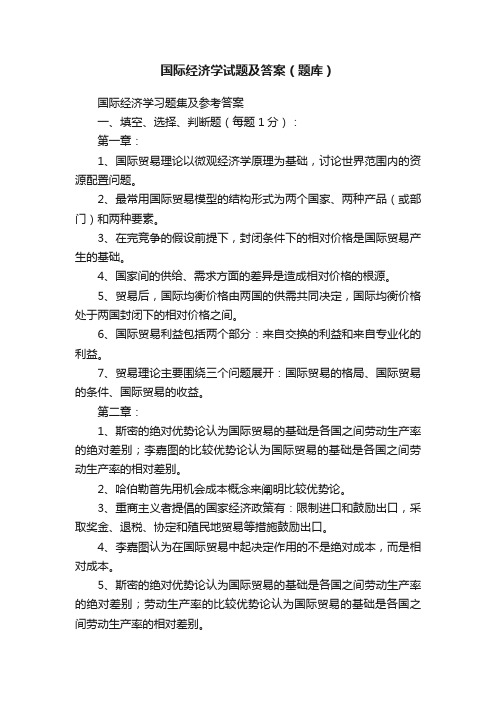
国际经济学试题及答案(题库)国际经济学习题集及参考答案一、填空、选择、判断题(每题1分):第一章:1、国际贸易理论以微观经济学原理为基础,讨论世界范围内的资源配置问题。
2、最常用国际贸易模型的结构形式为两个国家、两种产品(或部门)和两种要素。
3、在完竞争的假设前提下,封闭条件下的相对价格是国际贸易产生的基础。
4、国家间的供给、需求方面的差异是造成相对价格的根源。
5、贸易后,国际均衡价格由两国的供需共同决定,国际均衡价格处于两国封闭下的相对价格之间。
6、国际贸易利益包括两个部分:来自交换的利益和来自专业化的利益。
7、贸易理论主要围绕三个问题展开:国际贸易的格局、国际贸易的条件、国际贸易的收益。
第二章:1、斯密的绝对优势论认为国际贸易的基础是各国之间劳动生产率的绝对差别;李嘉图的比较优势论认为国际贸易的基础是各国之间劳动生产率的相对差别。
2、哈伯勒首先用机会成本概念来阐明比较优势论。
3、重商主义者提倡的国家经济政策有:限制进口和鼓励出口,采取奖金、退税、协定和殖民地贸易等措施鼓励出口。
4、李嘉图认为在国际贸易中起决定作用的不是绝对成本,而是相对成本。
5、斯密的绝对优势论认为国际贸易的基础是各国之间劳动生产率的绝对差别;劳动生产率的比较优势论认为国际贸易的基础是各国之间劳动生产率的相对差别。
6、在李嘉图模型中,生产可能性边界线方程是一个线性方程式,表示A、B两国的PPF曲线是一条直线段。
7、重商主义者提倡的国家经济政策有:限制进口和鼓励出口,采取奖金、退税、协定和殖民地贸易等措施鼓励出口。
8、李嘉图认为在国际贸易中起决定作用的不是绝对成本,而是相对成本。
9、机会成本概念表明:彼种选择的机会成本就构成此种选择的机会成本。
选择题:1、首先用机会成本理论来解释比较优势原理的学者是: C、A、李嘉图B、罗布津斯基C、哈伯勒D、穆勒第三章:1、要素禀赋理论最初是由赫克歇尔和俄林提出的,后经萨缪尔森等人加工不断完善。
国际经济学考试试题

国际经济学考试试题一、单项选择题(每题 2 分,共 30 分)1、从国际经济资源流动的难度看,最容易流动的要素是()A 商品B 资本C 人员D 技术2、假定闭关自守的状态下,X 商品的价格,在 A 国是 10 美元,在 B 国是 8 美元,C 国是 6 美元,并且 A 国是小国,不能通过贸易影响 B 国和 C 国的价格。
如果 A 国对从 B 国和 C 国进口的 X 商品最初征收非歧视性的 100%的从价税,那么,A 国是()A 贸易创造国B 贸易转移国C 贸易受损国D 无法确定3、比较优势理论认为国际贸易的驱动力是()A 劳动生产率的差异B 技术水平的差异C 产品品质的差异D 价格的差异4、以下哪种贸易政策会降低本国的福利水平()A 出口补贴B 进口关税C 进口配额D 自愿出口限制5、能反映规模经济理论本意的是()A 规模报酬递减B 规模报酬递增C 规模报酬不变D 以上都不对6、幼稚产业保护论的提出者是()A 亚当·斯密B 大卫·李嘉图C 汉密尔顿D 李斯特7、当一国政府对某种产品征收进口关税时,若该产品的需求弹性大于供给弹性,生产者与消费者承担关税的程度是()A 前者大于后者B 后者大于前者C 两者相等D 不确定8、一国货币贬值对其进出口收支产生何种影响()A 出口增加,进口减少B 出口减少,进口增加C 出口增加,进口增加D 出口减少,进口减少9、在浮动汇率制下,当一国国际收支出现逆差时,该国货币汇率会()A 上升B 下降C 不变D 不确定10、以下哪项不是国际收支平衡表中的项目()A 经常项目B 资本项目C 错误与遗漏项目D 国内生产总值项目11、购买力平价理论的基础是()A 一价定律B 利率平价C 相对购买力平价D 绝对购买力平价12、国际收支调整的弹性分析法的假设前提不包括()A 不存在国际资本流动B 汇率由货币当局决定C 马歇尔勒纳条件成立D 进出口商品的供给弹性无穷大13、下列属于直接标价法的是()A 1 美元=68 人民币B 1 人民币=015 美元C 1 英镑=12 欧元D 1 欧元=085 英镑14、蒙代尔弗莱明模型主要分析在资本完全流动的情况下,()政策的有效性。
国际经济学题库(含参考答案)
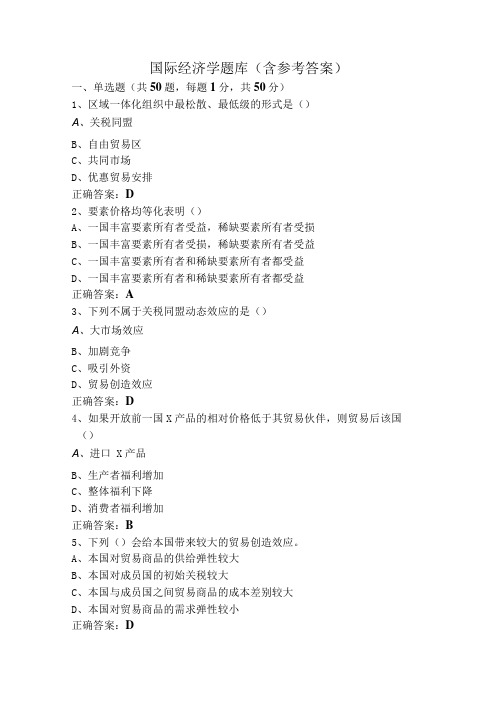
国际经济学题库(含参考答案)一、单选题(共50题,每题1分,共50分)1、区域一体化组织中最松散、最低级的形式是()A、关税同盟B、自由贸易区C、共同市场D、优惠贸易安排正确答案:D2、要素价格均等化表明()A、一国丰富要素所有者受益,稀缺要素所有者受损B、一国丰富要素所有者受损,稀缺要素所有者受益C、一国丰富要素所有者和稀缺要素所有者都受益D、一国丰富要素所有者和稀缺要素所有者都受益正确答案:A3、下列不属于关税同盟动态效应的是()A、大市场效应B、加剧竞争C、吸引外资D、贸易创造效应正确答案:D4、如果开放前一国X产品的相对价格低于其贸易伙伴,则贸易后该国()A、进口 X产品B、生产者福利增加C、整体福利下降D、消费者福利增加正确答案:B5、下列()会给本国带来较大的贸易创造效应。
A、本国对贸易商品的供给弹性较大B、本国对成员国的初始关税较大C、本国与成员国之间贸易商品的成本差别较大D、本国对贸易商品的需求弹性较小正确答案:D6、初级产品的出口价格若下降,其出口量将增加,出口总收入()A、不变B、增加C、下降D、不确定正确答案:C7、马歇尔一勒纳条件所要说明的是在供给弹性()的情况下,本币贬值能够改善贸易收支的进出口需求弹性条件。
A、零B、无穷大C、1D^大于零小于1正确答案:B8、假设中国和美国都能生产小麦和布,中国将一单位劳动时间全部生产布,可以生产50米;全部生产小麦,可以生产80千克;美国将一单位劳动时间全部生产布,可以生产40米;全部生产小麦,可以生产 100千克。
如果开放后的国际交换比价为1米布=L 8千克小麦,则下列说法正确的是()A、无法比较美国和中国的获利情况B、中国从贸易开放中获利更多C、美国和中国从贸易开放中获利相同D、美国从贸易开放中获利更多正确答案:D9、下列不属于国际收支平衡表资本项目的是()A、利息收支B、短期信贷C、短期证券买卖D、票据买卖正确答案:A10、消费者剩余是()A、消费者为了商品的消费而必须向政府支付的东西B、消费者通过低于市场价格的价格而得到的收益C、消费者购买商品所需支付的价格低于其愿意支付的价格而获得的收益D、消费者可以在各种价格水平得到的收益正确答案:C11、外汇市场中的即期交易不包含()A、套汇B、投机C、国际贸易结算D、银行同业拆借正确答案:B12、如果一个中国工人能生产3匹布或者1辆汽车,一个美国工人能生产4匹布或2辆汽车,则能促进中国与美国进行贸易并各自收益的交换比率是()A、4匹布换2辆汽车B、3匹布换1辆汽车C、3匹布换2辆汽车D、5匹布换2辆汽车正确答案:D13、国际经济学的研究对象是()A、国际商品流动B、国际收支平衡C、世界范围内的稀缺资源的最优配置D^国际人员流动正确答案:C14、根据国民收入决定方程Y=C+I+G+X-M,国际收支的吸收分析法中的“吸收”是指()A、YB、C+IC、C+I+GD、X-M正确答案:C15、开放经济条件下的宏观经济政策目标是()A、追求贸易顺差B、汇率稳定C、扩大出口D、国际收支平衡正确答案:D16、在进行贸易后,一国的收入分配会发生如下变化,()A、收入由消费者转向生产者B、受到进口商品竞争压力的国内生产者遭受损失,而出口商品的生产者则会受益C、消费者受损,生产者受益D、作为整体的国家受益,而个人则会受到损失正确答案:B17、商品和服务贸易记录在国际收支平衡表中的()A、经常项目B、误差和遗漏项目C、官方结算项目D、资本项目正确答案:A18、下列哪个行业最有可能具有内部规模经济?()A、好莱坞的电影业B、加州硅谷的半导体产业C、美国的大型农场D、北京中关村的电脑城正确答案:C19、采用()的配额分配方式,配额的福利效果与关税一样。
国际经济学试题及答案

国际经济学试题及答案一、单项选择题(每题2分,共20分)1. 国际经济学研究的核心问题是:A. 国际贸易B. 国际金融C. 国际投资D. 全球化答案:A2. 比较优势理论是由哪位经济学家提出的?A. 大卫·李嘉图B. 亚当·斯密C. 约翰·梅纳德·凯恩斯D. 阿尔弗雷德·马歇尔答案:A3. 根据赫克歇尔-俄林理论,一个国家会专门生产并出口其:A. 劳动力密集型商品B. 资本密集型商品C. 技术密集型商品D. 资源密集型商品答案:B4. 汇率波动对国际贸易的影响主要体现在:A. 价格竞争力B. 贸易政策C. 贸易壁垒D. 贸易协定答案:A5. 国际货币基金组织(IMF)的主要职能不包括:A. 监督成员国的经济政策B. 提供短期贷款以解决国际收支不平衡C. 促进国际贸易自由化D. 为成员国提供技术援助答案:C6. 世界贸易组织(WTO)的主要目标是:A. 促进全球经济增长B. 减少全球贫困C. 促进国际贸易自由化D. 维护世界和平答案:C7. 根据购买力平价理论,如果一国的货币贬值,那么该国的:A. 出口会增加B. 进口会增加C. 出口和进口都会增加D. 出口和进口都不会增加答案:A8. 国际直接投资(FDI)与国际间接投资的主要区别在于:A. 投资规模B. 投资期限C. 投资方式D. 投资回报答案:C9. 跨国公司在全球范围内进行生产和销售活动,其主要目的是:A. 降低成本B. 增加市场份额C. 规避贸易壁垒D. 所有上述选项答案:D10. 国际经济一体化的主要形式不包括:A. 自由贸易区B. 共同市场C. 关税同盟D. 双边贸易协定答案:D二、多项选择题(每题3分,共15分)1. 以下哪些因素会影响一个国家的贸易模式?A. 资源禀赋B. 技术水平C. 消费者偏好D. 贸易政策答案:ABCD2. 国际收支平衡表主要包括以下哪些部分?A. 经常账户B. 资本和金融账户C. 储备资产D. 政府预算答案:ABC3. 以下哪些是国际经济一体化的积极效应?A. 贸易创造B. 规模经济C. 投资自由化D. 货币贬值答案:ABC4. 国际货币体系的主要功能包括:A. 提供稳定的汇率B. 促进国际贸易和投资C. 维护国际金融稳定D. 促进全球经济增长答案:ABC5. 国际金融市场的主要参与者包括:A. 银行B. 跨国公司C. 政府D. 个人投资者答案:ABCD三、简答题(每题5分,共20分)1. 简述绝对优势理论和比较优势理论的主要区别。
国际经济学期末考试题
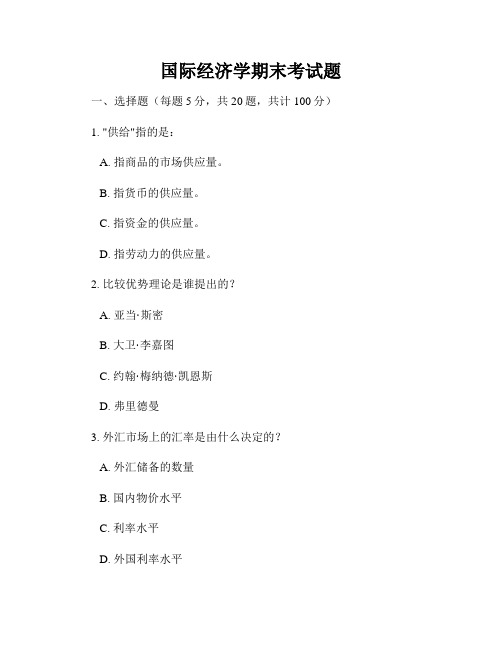
国际经济学期末考试题一、选择题(每题5分,共20题,共计100分)1. "供给"指的是:A. 指商品的市场供应量。
B. 指货币的供应量。
C. 指资金的供应量。
D. 指劳动力的供应量。
2. 比较优势理论是谁提出的?A. 亚当·斯密B. 大卫·李嘉图C. 约翰·梅纳德·凯恩斯D. 弗里德曼3. 外汇市场上的汇率是由什么决定的?A. 外汇储备的数量B. 国内物价水平C. 利率水平D. 外国利率水平4. 以下哪个国际组织主要致力于促进全球贸易自由化?A. 世界贸易组织(WTO)B. 国际货币基金组织(IMF)C. 世界银行(WB)D. 美洲国家组织(OAS)5. 货币政策的主要目标之一是:A. 维持物价稳定B. 促进经济增长C. 降低利率D. 减少失业率6. 国际分工的好处包括:A. 提高生产效率B. 扩大市场规模C. 促进技术创新D. 所有选项都正确7. 如果一个国家的汇率升值,会对该国的贸易产生什么影响?A. 减少出口,增加进口B. 增加出口,减少进口C. 减少出口和进口D. 增加出口和进口8. 当通货膨胀率高于预期的时候,央行可能会采取的货币政策措施是:A. 加息B. 降息C. 货币放松D. 不采取任何措施9. 名义利率是指:A. 不包括通货膨胀的利率B. 超额储蓄的利率C. 包括通货膨胀的利率D. 市场利率10. 直接投资是指:A. 跨国公司间的资金流动B. 外商在本国购买股票和债券C. 资本流动到国际间接投资基金D. 政府间的经济援助二、简答题(每题20分,共计40分)1. 解释比较优势理论,并举例说明其应用。
2. 简述外汇市场的功能和作用。
三、论述题(共计60分)1. 请阐述货币政策对经济的影响,以及央行在实施货币政策时需要考虑哪些因素。
2. 选择一个国际组织,介绍其目标、职责以及对国际经济的影响。
四、分析题(共计80分)某国经济遭受一次严重的金融危机,失业率飙升,通货膨胀率上升,人民币贬值,并且国内外投资都受到了打击。
国际经济学试题及答案
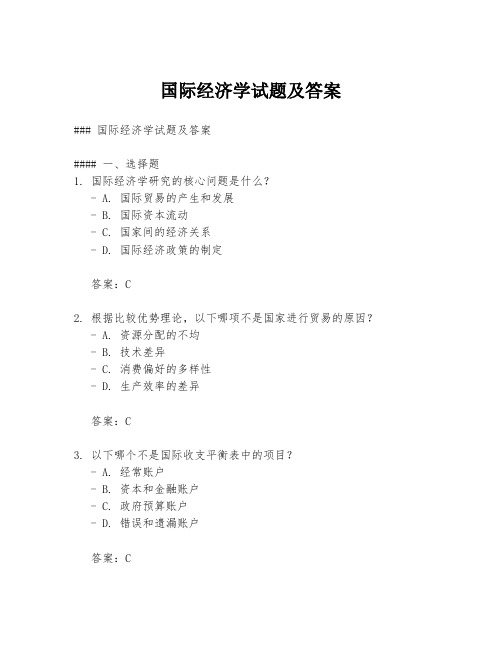
国际经济学试题及答案### 国际经济学试题及答案#### 一、选择题1. 国际经济学研究的核心问题是什么?- A. 国际贸易的产生和发展- B. 国际资本流动- C. 国家间的经济关系- D. 国际经济政策的制定答案:C2. 根据比较优势理论,以下哪项不是国家进行贸易的原因? - A. 资源分配的不均- B. 技术差异- C. 消费偏好的多样性- D. 生产效率的差异答案:C3. 以下哪个不是国际收支平衡表中的项目?- A. 经常账户- B. 资本和金融账户- C. 政府预算账户- D. 错误和遗漏账户答案:C#### 二、简答题1. 简述绝对优势理论的基本内容。
绝对优势理论由亚当·斯密提出,认为如果一个国家在生产某种商品上比其他国家更有效率,即生产成本更低,那么这个国家在该商品上具有绝对优势。
根据这一理论,具有绝对优势的国家应该专门生产并出口其具有绝对优势的商品,同时进口其他国家具有绝对优势的商品,从而实现资源的最优配置和国际贸易的互利。
2. 什么是保护主义?保护主义对国际贸易有何影响?保护主义是一种经济政策,旨在通过关税、配额、补贴等手段保护国内产业免受外国竞争的影响。
保护主义可能会提高国内产业的竞争力,但同时也可能导致资源配置效率降低,增加消费者成本,限制国际贸易的发展,并可能引发贸易战,对全球经济产生负面影响。
#### 三、计算题1. 假设一个国家生产小麦和玉米,生产一单位小麦需要4小时劳动,生产一单位玉米需要2小时劳动。
另一个国家生产一单位小麦需要6小时劳动,生产一单位玉米需要3小时劳动。
请计算两国的比较优势,并说明它们应该如何进行贸易。
- 第一个国家生产小麦的机会成本是0.5单位玉米(4小时/2小时),生产玉米的机会成本是2单位小麦(2小时/4小时)。
- 第二个国家生产小麦的机会成本是2单位玉米(6小时/3小时),生产玉米的机会成本是0.5单位小麦(3小时/6小时)。
第一个国家在生产小麦上有比较优势,因为它的机会成本较低(0.5 vs 2)。
考研国际经济学真题试卷
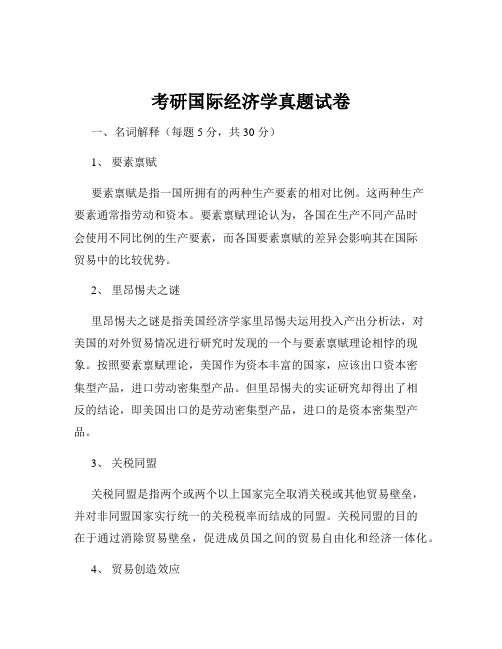
考研国际经济学真题试卷一、名词解释(每题 5 分,共 30 分)1、要素禀赋要素禀赋是指一国所拥有的两种生产要素的相对比例。
这两种生产要素通常指劳动和资本。
要素禀赋理论认为,各国在生产不同产品时会使用不同比例的生产要素,而各国要素禀赋的差异会影响其在国际贸易中的比较优势。
2、里昂惕夫之谜里昂惕夫之谜是指美国经济学家里昂惕夫运用投入产出分析法,对美国的对外贸易情况进行研究时发现的一个与要素禀赋理论相悖的现象。
按照要素禀赋理论,美国作为资本丰富的国家,应该出口资本密集型产品,进口劳动密集型产品。
但里昂惕夫的实证研究却得出了相反的结论,即美国出口的是劳动密集型产品,进口的是资本密集型产品。
3、关税同盟关税同盟是指两个或两个以上国家完全取消关税或其他贸易壁垒,并对非同盟国家实行统一的关税税率而结成的同盟。
关税同盟的目的在于通过消除贸易壁垒,促进成员国之间的贸易自由化和经济一体化。
4、贸易创造效应贸易创造效应是指关税同盟成立后,成员国之间相互取消关税和非关税壁垒,使得国内生产成本较高的产品被来自同盟内生产成本较低的产品所替代,从而扩大了贸易规模,提高了资源配置效率。
5、贸易转移效应贸易转移效应是指关税同盟成立后,成员国原先从同盟外成本较低的国家进口的产品,转为从同盟内成本较高的国家进口,从而降低了资源配置效率。
6、外汇倾销外汇倾销是指一国利用本国货币对外贬值的机会,扩大出口、限制进口的一种手段。
当本国货币贬值后,以外币表示的本国出口商品价格下降,从而提高了出口商品在国际市场上的竞争力;同时,以本国货币表示的进口商品价格上升,从而削弱了进口商品的竞争力。
二、简答题(每题 10 分,共 50 分)1、简述比较优势理论的主要内容。
比较优势理论由大卫·李嘉图提出。
该理论认为,即使一个国家在生产两种商品上都处于劣势,而另一个国家在生产两种商品上都处于优势,但只要两国生产两种商品的劳动生产率的比率存在差异,处于劣势的国家在“劣中选优”,即生产两种商品中劳动生产率相对较高的那种商品;处于优势的国家在“优中选劣”,即生产两种商品中劳动生产率相对较低的那种商品,通过专业化分工和国际贸易,双方仍能从中获利。
国际经济学试题及答案
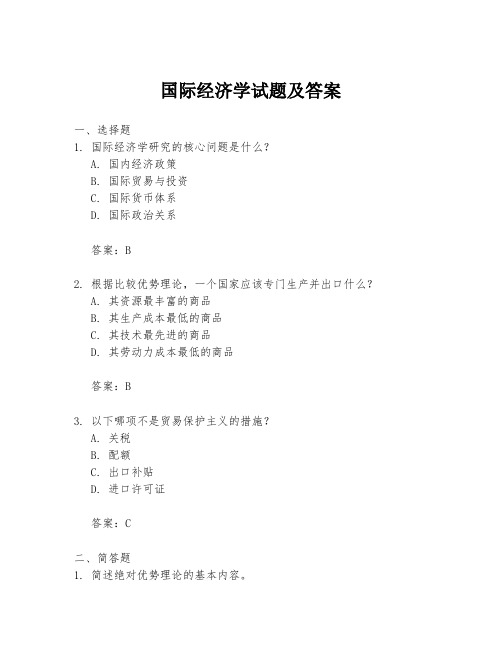
国际经济学试题及答案一、选择题1. 国际经济学研究的核心问题是什么?A. 国内经济政策B. 国际贸易与投资C. 国际货币体系D. 国际政治关系答案:B2. 根据比较优势理论,一个国家应该专门生产并出口什么?A. 其资源最丰富的商品B. 其生产成本最低的商品C. 其技术最先进的商品D. 其劳动力成本最低的商品答案:B3. 以下哪项不是贸易保护主义的措施?A. 关税B. 配额C. 出口补贴D. 进口许可证答案:C二、简答题1. 简述绝对优势理论的基本内容。
答案:绝对优势理论由亚当·斯密提出,主张一个国家应该生产并出口其生产效率最高的商品,进口其生产效率最低的商品。
该理论认为,即使一个国家在所有商品的生产上都没有绝对优势,它仍然可以通过专业化生产效率相对较高的商品来获得贸易利益。
2. 什么是国际收支平衡表?答案:国际收支平衡表是一个记录一个国家与其他国家之间所有经济交易的统计报表。
它包括经常账户、资本和金融账户以及官方储备账户。
经常账户记录商品和服务的交易,资本和金融账户记录资本流动和金融资产的交易,官方储备账户记录中央银行的外汇储备变动。
三、论述题1. 论述汇率变动对国际贸易的影响。
答案:汇率变动对国际贸易有重要影响。
当一个国家的货币升值时,其出口商品在国际市场上的价格上升,竞争力下降,导致出口减少;同时,进口商品的价格下降,国内消费者更倾向于购买外国商品,导致进口增加。
相反,当一个国家的货币贬值时,其出口商品的价格下降,竞争力增强,促进出口;进口商品的价格上升,抑制进口。
此外,汇率变动还会影响跨国公司的投资决策,因为投资成本和收益会随着汇率变动而变化。
2. 分析全球化对发展中国家的影响。
答案:全球化为发展中国家带来了机遇和挑战。
机遇方面,全球化促进了资本、技术和信息的流动,为发展中国家提供了更多的市场机会和投资机会,有助于提高生产效率和经济增长。
挑战方面,全球化加剧了国际竞争,对发展中国家的产业和就业产生压力,可能导致收入差距扩大。
国际经济学复习题+答案

国际经济学复习题+答案一、单选题(共68题,每题1分,共68分)1.目前,欧盟正在朝()方向努力。
A、经济联盟B、关税同盟C、完全经济一体化D、共同市场正确答案:C2.在绝对技术差异论与相对技术差异论的论证过程中,机会成本()A、递增B、不变C、先递增后递减D、递减正确答案:B3.以下哪项交易应记入美国国际收支帐户的借方()A、一家意大利公司向其在美国的股东支付 500 万美元的红利B、一家法国公司为其在意大利开辟的旅游点雇佣了四名美国潜水教练C、丰田公司在美国建立了一家工厂以生产汽车D、长期在美国的阿富汗难民向其国内亲戚汇款正确答案:D4.按照国际收支平衡表的编制原理,凡引起外汇流入的项目应记入()。
A、贷方B、附录C、借方D、借贷双方正确答案:A5.下列非关税壁垒中,()有利于促进出口量的增加。
A、出口补贴B、技术标准C、自愿出口限制D、配额正确答案:A6.不改变贸易结构,只改变贸易规模的增长方式为()A、偏向出口的生产要素增长B、生产要素等比例增长C、悲惨的增长D、偏向进口的生产要素增长正确答案:B7.生产要素偏向进口增长会()A、使出口贸易规模扩大B、使进口贸易规模下降C、使出口部门的生产扩大D、使进口竞争部门的生产缩小正确答案:B8.一国利用原材料或资源密集型产品的出口增加本国收入,进而提高本国的储蓄和投资水平,带动经济发展。
该理论被称为()A、比较优势理论B、产品生命周期理论C、剩余物质出口理论D、大宗产品贸易理论正确答案:D9.在一国收入水平不变的情况下,用于分析汇率变动以及进出口商品价格变动对贸易收支以及国际收支失衡调节机理的理论称为()A、国际收支的弹性分析法B、国际收支的吸收分析法C、国际收支的乘数分析法D、国际收支的货币分析法正确答案:A10.下列()会给本国带来较大的贸易创造效应。
A、本国对成员国的初始关税较大B、本国对贸易商品的需求弹性较小C、本国对贸易商品的供给弹性较大D、本国与成员国之间贸易商品的成本差别较大正确答案:B11.下列关于新新贸易理论的说法错误的是()A、只有那些具有劳动生产率优势的企业才能进行国际贸易B、只有生产率最高的那部分企业才能成为跨国公司C、从企业异质性角度解释国际贸易和投资的现象D、建立在完全竞争的基础之上正确答案:D12.蒙代尔认为,在固定汇率制度下,扩张性的财政政策()A、会恶化资本项目B、有利于改善国际收支C、对实现内部平衡有效D、有利于改善经常项目正确答案:A13.三大外汇交易中心不包含()A、东京B、香港C、纽约D、伦敦正确答案:B14.保护贸易政策的根本特点是()A、奖出限入B、鼓励出口C、奖入限出D、限制进口正确答案:A15.下列不属于绝对技术差异论与相对技术差异论共同的假设条件的是()A、生产要素在两国之间可以自由流动B、生产要素都被充分利用C、生产要素在一国内部各部门间可以自由流动D、生产要素流动时机会成本不变正确答案:A16.国际收支统计的记帐方法是()A、复式记帐法B、流水记帐法C、收付记帐法D、单式记帐法正确答案:A17.国际经济政策协调比较成功且协调水平比较高的区域组织是()A、东盟B、北美自由贸易区C、欧盟D、亚太经合组织正确答案:C18.商品和服务贸易记录在国际收支平衡表中的()A、经常项目B、误差和遗漏项目C、资本项目D、官方结算项目正确答案:A19.在固定汇率制度下,一国紧缩货币政策将导致()A、本国利率上升,国际收支改善B、本国利率下降,国际收支改善C、本国利率上升,国际收支恶化D、本国利率下降,国际收支恶化正确答案:A20.对于赫克歇尔—俄林理论来说,导致不同国家间相对商品价格差异的最主要的因素是()A、要素禀赋B、消费偏好C、国民收入D、技术正确答案:A21.提出幼稚产业保护论的是()A、大卫·李嘉图B、汉密尔顿C、亚当·斯密D、李斯特正确答案:D22.在国际收支平衡表中,人为设立的项目是()A、经常项目B、资本项目C、官方结算项目D、误差和遗漏项目正确答案:D23.当货币远期汇率低于即期汇率时,外汇交易的专门术语称此为()A、升值B、升水C、贴水D、平价正确答案:C24.赫克歇尔—俄林模型认为国际贸易的根本原因是()A、各国技术水平不同B、各国生产要素禀赋不同C、各国产品技术含量不同D、各国劳动生产率不同正确答案:B25.从一般经济效应分析,商品出口会使该国福利()A、下降B、不变C、不确定D、上升正确答案:D26.新贸易理论主要解释()A、发达国家与发展中国家之间的贸易B、产业间贸易C、发展中国家之间的贸易D、产业内贸易正确答案:D27.组成关税同盟后,成员国之间相互取消关税带来的贸易规模扩大和福利增加,我们称为()A、贸易转移B、贸易创造C、交换所得D、专业化所得正确答案:B28.贫困化增长的一个条件是()A、该国是一个小国B、外国对该国的出口需求具有弹性C、贸易在国民经济中的比重不大D、国家的增长偏向出口产业正确答案:D29.成员国间实行自由贸易的优惠贸易协定和共同的外部关税是()A、经济联盟B、关税同盟C、自由贸易区D、共同市场正确答案:B30.一种产品的竞争优势并非长期固定在某一个特定的国家,而是从技术发明国转向生产成本较低的国家,描述这一现象的理论是()A、雁行模式理论B、叠需求理论C、产品生命周期理论D、要素禀赋理论重正确答案:C31.当出现需求无弹性时,一国货币贬值可以导致()A、出口换汇增加B、贸易收支恶化C、出口数量下降D、贸易收支改善正确答案:B32.下列不属于重商主义观点的是()A、奖励出口,限制进口B、货币是财富的唯一形式C、国际贸易对各参与国都有利D、国际贸易是一种“零和”博弈正确答案:C33.绝对技术差异论的提出者是()A、魁奈B、李嘉图C、斯密D、俄林正确答案:C34.一国的国际收支出现逆差时,在外汇市场上表现为()A、外汇的供给大于需求B、外汇的供给小于需求C、外汇的供给等于需求D、外汇供求处于不确定状态正确答案:B35.从()阶段开始,商品可以在成员国之间自由流动。
国际经济学试题及答案
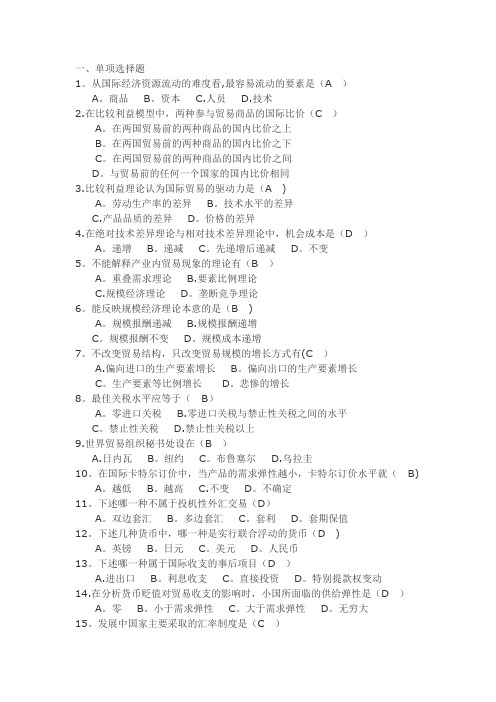
一、单项选择题1。
从国际经济资源流动的难度看,最容易流动的要素是(A)A。
商品B。
资本 C.人员 D.技术2.在比较利益模型中,两种参与贸易商品的国际比价(C)A。
在两国贸易前的两种商品的国内比价之上B。
在两国贸易前的两种商品的国内比价之下C。
在两国贸易前的两种商品的国内比价之间D。
与贸易前的任何一个国家的国内比价相同3.比较利益理论认为国际贸易的驱动力是(A)A。
劳动生产率的差异B。
技术水平的差异C.产品品质的差异D。
价格的差异4.在绝对技术差异理论与相对技术差异理论中,机会成本是(D)A。
递增B。
递减C。
先递增后递减D。
不变5。
不能解释产业内贸易现象的理论有(B)A。
重叠需求理论 B.要素比例理论C.规模经济理论D。
垄断竞争理论6。
能反映规模经济理论本意的是(B)A。
规模报酬递减 B.规模报酬递增C。
规模报酬不变D。
规模成本递增7。
不改变贸易结构,只改变贸易规模的增长方式有(C)A.偏向进口的生产要素增长B。
偏向出口的生产要素增长C。
生产要素等比例增长D。
悲惨的增长8。
最佳关税水平应等于(B)A。
零进口关税 B.零进口关税与禁止性关税之间的水平C。
禁止性关税 D.禁止性关税以上9.世界贸易组织秘书处设在(B)A.日内瓦B。
纽约C。
布鲁塞尔 D.乌拉圭10。
在国际卡特尔订价中,当产品的需求弹性越小,卡特尔订价水平就(B) A。
越低B。
越高 C.不变D。
不确定11。
下述哪一种不属于投机性外汇交易(D)A。
双边套汇B。
多边套汇C。
套利D。
套期保值12。
下述几种货币中,哪一种是实行联合浮动的货币(D)A。
英镑B。
日元C。
美元D。
人民币13。
下述哪一种属于国际收支的事后项目(D)A.进出口B。
利息收支C。
直接投资D。
特别提款权变动14.在分析货币贬值对贸易收支的影响时,小国所面临的供给弹性是(D)A。
零B。
小于需求弹性C。
大于需求弹性D。
无穷大15。
发展中国家主要采取的汇率制度是(C)A。
固定汇率制 B.浮动汇率制 C.钉住汇率制 D.联合浮动制16。
国际经济学试题.doc
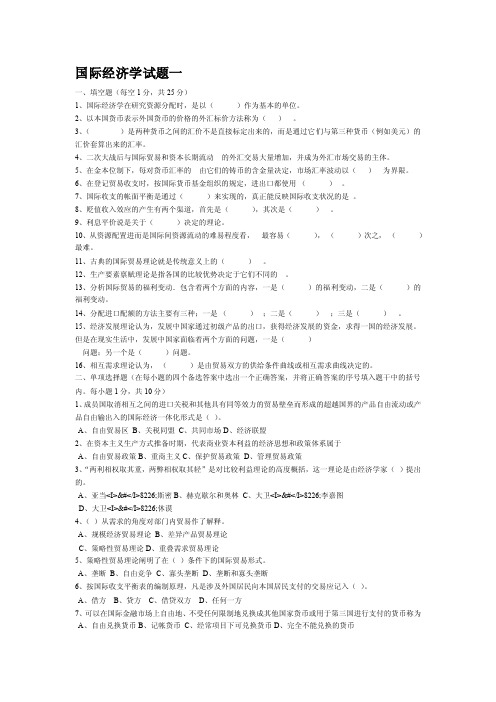
国际经济学试题一一、填空题(每空1分,共25分)1、国际经济学在研究资源分配时,是以()作为基本的单位。
2、以本国货币表示外国货币的价格的外汇标价方法称为()。
3、()是两种货币之间的汇价不是直接标定出来的,而是通过它们与第三种货币(例如美元)的汇价套算出来的汇率。
4、二次大战后与国际贸易和资本长期流动的外汇交易大量增加,并成为外汇市场交易的主体。
5、在金本位制下,每对货币汇率的由它们的铸币的含金量决定,市场汇率波动以()为界限。
6、在登记贸易收支时,按国际货币基金组织的规定,进出口都使用()。
7、国际收支的帐面平衡是通过()来实现的,真正能反映国际收支状况的是。
8、贬值收入效应的产生有两个渠道,首先是(),其次是()。
9、利息平价说是关于()决定的理论。
10、从资源配置进而是国际间资源流动的难易程度看,最容易(),()次之,()最难。
11、古典的国际贸易理论就是传统意义上的()。
12、生产要素禀赋理论是指各国的比较优势决定于它们不同的。
13、分析国际贸易的福利变动.包含着两个方面的内容,一是()的福利变动,二是()的福利变动。
14、分配进口配额的方法主要有三种;一是();二是();三是()。
15、经济发展理论认为,发展中国家通过初级产品的出口,获得经济发展的资金,求得一国的经济发展。
但是在现实生活中,发展中国家面临着两个方面的问题,一是()问题;另一个是()问题。
16、相互需求理论认为,()是由贸易双方的供给条件曲线或相互需求曲线决定的。
二、单项选择题(在每小题的四个备选答案中选出一个正确答案,并将正确答案的序号填入题干中的括号内。
每小题1分,共10分)1、成员国取消相互之间的进口关税和其他具有同等效力的贸易壁垒而形成的超越国界的产品自由流动或产品自由输出入的国际经济一体化形式是()。
A、自由贸易区B、关税同盟C、共同市场D、经济联盟2、在资本主义生产方式推备时期,代表商业资本利益的经济思想和政策体系属于A、自由贸易政策B、重商主义C、保护贸易政策D、管理贸易政策3、“两利相权取其重,两弊相权取其轻”是对比较利益理论的高度概括,这一理论是由经济学家()提出的。
(完整word版)国际经济学测试题
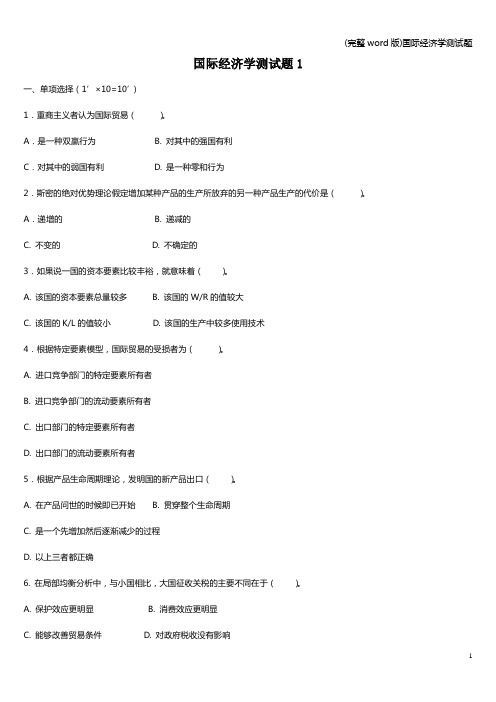
国际经济学测试题1一、单项选择(1’×10=10’)1.重商主义者认为国际贸易()。
A.是一种双赢行为 B. 对其中的强国有利C.对其中的弱国有利 D. 是一种零和行为2.斯密的绝对优势理论假定增加某种产品的生产所放弃的另一种产品生产的代价是()。
A.递增的 B. 递减的C. 不变的D. 不确定的3.如果说一国的资本要素比较丰裕,就意味着()。
A. 该国的资本要素总量较多B. 该国的W/R的值较大C. 该国的K/L的值较小D. 该国的生产中较多使用技术4.根据特定要素模型,国际贸易的受损者为()。
A. 进口竞争部门的特定要素所有者B. 进口竞争部门的流动要素所有者C. 出口部门的特定要素所有者D. 出口部门的流动要素所有者5.根据产品生命周期理论,发明国的新产品出口()。
A. 在产品问世的时候即已开始B. 贯穿整个生命周期C. 是一个先增加然后逐渐减少的过程D. 以上三者都正确6. 在局部均衡分析中,与小国相比,大国征收关税的主要不同在于()。
A. 保护效应更明显B. 消费效应更明显C. 能够改善贸易条件D. 对政府税收没有影响7.如果一国在征收进口税时,对最终产品征收的关税低于中间产品,则可以使关税的实际保护效果()。
A. 增大B. 变小C. 没有影响D. 无法判断8.购买力平价理论的基础是()。
A. 粘性价格的存在B. 货币数量理论C. 马歇尔-勒纳条件D. 一价定律9.根据吸收分析法,贬值一定会()。
A. 导致国内总收入的增加B. 改善国际收支C. 促使国内货币供求重新平衡D. 上述说法都不对10. 根据斯旺图示,用来调节外部均衡的手段是()。
A. 支出转换政策B. 支出调整政策C. 本国的货币政策D. 本国的财政政策二、多项选择(1’×10=10’)1. 能够解释二战以后国际贸易流向新格局的理论包括()。
A.规模经济理论 B. 产业内贸易理论C.产品差异化理论 D. 需求偏好相似理论E.要素禀赋理论2. 对里昂惕夫之谜进行解释的学说包括()。
国际经济学期末考试题及答案英语

国际经济学期末考试题及答案英语1. 名词解释(每题5分,共20分)- 1.1. 比较优势- 1.2. 贸易壁垒- 1.3. 国际货币体系- 1.4. 汇率2. 简答题(每题10分,共30分)- 2.1. 简述国际经济学中的“赫克歇尔-俄林理论”。
- 2.2. 描述汇率波动对国际贸易的影响。
- 2.3. 解释全球化对发展中国家的利弊。
3. 计算题(每题15分,共30分)- 3.1. 假设一个国家生产两种商品,商品A的劳动生产率是商品B 的两倍。
如果该国生产1单位商品A需要4小时,生产1单位商品B 需要8小时,请计算该国在商品A和商品B上的比较优势。
- 3.2. 某国货币对美元的汇率从1美元兑换5本国货币变为1美元兑换6本国货币。
如果该国的出口商品价格为10本国货币,那么出口商品在国际市场上的价格变化了多少?4. 论述题(每题20分,共40分)- 4.1. 论述世界贸易组织(WTO)在国际经济中的作用及其面临的挑战。
- 4.2. 分析当前全球经济形势下,中国如何通过“一带一路”倡议促进国际贸易和投资。
答案1. 名词解释- 1.1. 比较优势:是指一个国家在生产某种商品时,相对于其他国家拥有较低的机会成本,即使其生产效率不是最高的。
- 1.2. 贸易壁垒:是指国家或地区为了保护本国产业而设置的进口限制措施,如关税、配额、进口许可证等。
- 1.3. 国际货币体系:是指各国货币之间汇率的确定方式及其相关的国际金融安排。
- 1.4. 汇率:是指一种货币兑换成另一种货币的比率。
2. 简答题- 2.1. “赫克歇尔-俄林理论”认为,一个国家会专门生产并出口其拥有相对丰富生产要素(如劳动、资本、土地等)的商品,从而在国际贸易中获得优势。
- 2.2. 汇率波动会影响商品的国际价格,导致进口商品价格上升或下降,进而影响消费者的购买意愿和生产者的生产决策。
- 2.3. 全球化为发展中国家带来了资金、技术和市场的机遇,但同时也带来了文化冲击、环境问题和经济不稳定等挑战。
国际经济学选择题有答案

国际经济学选择题有答案一、单项选择题1. 国际贸易理论的基石是哪一位经济学家的理论?A. 亚当·斯密B. 大卫·李嘉图C. 保罗·萨缪尔森D. 约翰·梅纳德·凯恩斯答案:B2. 下列哪项不是比较优势理论的假设条件?A. 资源禀赋差异B. 完全竞争市场C. 生产要素流动性D. 无运输成本答案:C3. 下列哪项是国际贸易中“倾销”的定义?A. 出口商在国内市场以低于国内市场价格的价格销售产品B. 出口商在国外市场以低于国内市场价格的价格销售产品C. 出口商在国外市场以高于国内市场价格的价格销售产品D. 出口商在国内市场以高于国内市场价格的价格销售产品答案:B4. 下列哪项不是影响汇率变动的因素?A. 利率差异B. 政府政策C. 经济增长率D. 自然灾害答案:D5. 下列哪项是“三元悖论”的表述?A. 一个国家不能同时实现资本自由流动、货币政策的独立性和汇率稳定B. 一个国家可以同时实现资本自由流动、货币政策的独立性和汇率稳定C. 汇率波动是国际贸易的必然结果D. 国际贸易会导致通货膨胀答案:A6. 下列哪项不是国际贸易中“要素禀赋理论”的假设条件?A. 生产要素不能自由流动B. 技术进步是中性的C. 资源禀赋差异D. 完全竞争市场答案:B7. 下列哪项是“特别提款权”(SDR)的定义?A. 国际货币基金组织发行的一种特别货币B. 国际货币基金组织发行的一种特别金融工具C. 国际货币基金组织发行的一种特别储备资产D. 国际货币基金组织发行的一种特别债券答案:C8. 下列哪项不是世界贸易组织(WTO)的宗旨?A. 促进贸易自由化B. 保护知识产权C. 促进经济一体化D. 促进环境保护答案:C9. 下列哪项是“贸易顺差”的定义?A. 一国出口额大于进口额B. 一国进口额大于出口额C. 一国贸易收支平衡D. 一国贸易收支逆差答案:A10. 下列哪项不是“经济全球化”的体现?A. 跨国公司的发展B. 国际贸易的增长C. 国际金融市场的整合D. 国内政策的独立性答案:D二、多项选择题1. 下列哪些是国际贸易理论的假设条件?A. 资源禀赋差异B. 生产要素流动性C. 完全竞争市场D. 无运输成本答案:A, C, D2. 下列哪些因素会影响汇率变动?A. 利率差异B. 政府政策C. 经济增长率D. 国际政治关系答案:A, B, C3. 下列哪些是国际贸易中“比较优势理论”的结论?A. 两国可以通过专业化生产并交换产品来获益B. 贸易的收益分配是公平的C. 贸易可以促进经济增长D. 贸易会导致资源错配答案:A, C4. 下列哪些是“要素禀赋理论”的假设条件?A. 生产要素不能自由流动B. 技术进步是中性的C. 资源禀赋差异D. 完全竞争市场答案:A, C5. 下列哪些是国际贸易中“贸易保护主义”的例子?A. 关税B. 进口配额C. 出口补贴D. 反倾销措施答案:A, B, D三、判断题1. 比较优势理论认为,所有国家都应该生产并出口所有商品。
《国际经济学》期末测试题及答案

《国际经济学》期末测试题及答案第一套一、名词解释1. 国际贸易:是指不同国家和地区之间进行的商品和服务的交换。
2. 比较优势:是指一个国家在生产某种商品或提供某种服务上,相对于其他国家具有更低的机会成本。
3. 绝对优势:是指一个国家在生产某种商品或提供某种服务上,其生产效率高于其他国家。
4. 全球化:是指全球范围内的经济、政治、文化、社会等各方面的交流和融合。
5. 贸易保护主义:是指通过实施关税、配额等手段,限制外国商品和服务进入本国市场的政策。
二、填空题1. _______是国际贸易的主要形式之一。
答案:自由贸易2. _______是决定国际贸易的重要因素。
答案:比较优势3. _______是全球化的主要推动力之一。
答案:科技进步4. _______是全球化的主要挑战之一。
答案:文化冲突5. _______是贸易保护主义的主要手段之一。
答案:关税壁垒三、单项选择题1. 以下哪个选项不是决定国际贸易的因素?A. 生产成本B. 市场需求C. 政府政策D. 个人喜好答案:D2. 以下哪个选项不是全球化的推动力?A. 科技进步B. 文化交流C. 政治冲突D. 经济发展答案:C3. 以下哪个选项不是全球化的挑战?A. 文化冲突B. 环境问题C. 经济发展不平衡D. 人口增长答案:D4. 以下哪个选项不是贸易保护主义的手段?A. 关税壁垒B. 配额制度C. 非关税壁垒D. 自由贸易协定答案:D5. 以下哪个选项不是全球化的影响?A. 经济一体化B. 文化交流C. 政治冲突D. 技术进步答案:C四、多项选择题1. 以下哪些因素会影响国际贸易?()A. 生产成本B. 市场需求C. 政府政策D. 个人喜好答案:ABC2. 以下哪些是全球化的推动力?()A. 科技进步B. 文化交流C. 政治冲突D. 经济发展答案:ABD3. 以下哪些是全球化的挑战?()A. 文化冲突B. 环境问题C. 经济发展不平衡D. 人口增长答案:ABCD4. 以下哪些是贸易保护主义的手段?()A. 关税壁垒B. 配额制度C. 非关税壁垒D. 自由贸易协定答案:ABC5. 以下哪些是全球化的影响?()A. 经济一体化B. 文化交流C. 政治冲突D. 技术进步答案:ABD五、判断题1. 如果一个国家在生产某种商品或提供某种服务上,其生产效率低于其他国家,那么这个国家就没有比较优势。
国际经济学试卷及答案
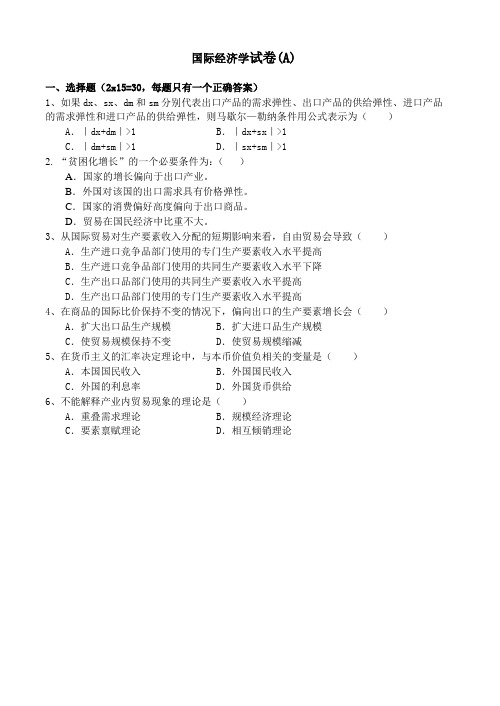
国际经济学试卷(A)
一、选择题(2x15=30,每题只有一个正确答案)
1、如果dx、sx、dm和sm分别代表出口产品的需求弹性、出口产品的供给弹性、进口产品的需求弹性和进口产品的供给弹性,则马歇尔—勒纳条件用公式表示为()A.|dx+dm|>1 B.|dx+sx|>1
C.|dm+sm|>1 D.|sx+sm|>1
2. “贫困化增长”的一个必要条件为:()
A.国家的增长偏向于出口产业。
B.外国对该国的出口需求具有价格弹性。
C.国家的消费偏好高度偏向于出口商品。
D.贸易在国民经济中比重不大。
3、从国际贸易对生产要素收入分配的短期影响来看,自由贸易会导致()
A.生产进口竞争品部门使用的专门生产要素收入水平提高
B.生产进口竞争品部门使用的共同生产要素收入水平下降
C.生产出口品部门使用的共同生产要素收入水平提高
D.生产出口品部门使用的专门生产要素收入水平提高
4、在商品的国际比价保持不变的情况下,偏向出口的生产要素增长会()
A.扩大出口品生产规模 B.扩大进口品生产规模
C.使贸易规模保持不变 D.使贸易规模缩减
5、在货币主义的汇率决定理论中,与本币价值负相关的变量是()
A.本国国民收入 B.外国国民收入
C.外国的利息率 D.外国货币供给
6、不能解释产业内贸易现象的理论是()
A.重叠需求理论 B.规模经济理论
C.要素禀赋理论 D.相互倾销理论。
- 1、下载文档前请自行甄别文档内容的完整性,平台不提供额外的编辑、内容补充、找答案等附加服务。
- 2、"仅部分预览"的文档,不可在线预览部分如存在完整性等问题,可反馈申请退款(可完整预览的文档不适用该条件!)。
- 3、如文档侵犯您的权益,请联系客服反馈,我们会尽快为您处理(人工客服工作时间:9:00-18:30)。
CHAPTER 1THE INTERNATIONAL ECONOMYMULTIPLE-CHOICE QUESTIONS1. A primary reason why nations conduct international trade is because:a. Some nations prefer to produce one thing while others produce otherthingsb. Resources are not equally distributed among all trading nationsc. Trade enhances opportunities to accumulate profitsd. Interest rates are not identical in all trading nations2. A main advantage of specialization results from:a. Economies of large-scale productionb. The specializing country behaving as a monopolyc. Smaller production runs resulting in lower unit costsd. High wages paid to foreign workers3. International trade in goods and services is sometimes used as asubstitute for all of the following except:a. International movements of capitalb. International movements of laborc. Domestic production of the same goods and servicesd. Domestic production of different goods and services4. If a nation has an open economy, it means that the nation:a. Allows private ownership of capitalb. Has flexible exchange ratesc. Has fixed exchange ratesd. Conducts trade with other countries12Test Bank for International Economics, 9e 5. International trade forces domestic firms to become more competitive interms of:a. The introduction of new productsb. Product design and qualityc. Product priced. All of the above6. The movement to free international trade is most likely to generateshort-term unemployment in which industries?a. Industries in which there are neither imports nor exportsb. Import-competing industriesc. Industries that sell to domestic and foreign buyersd. Industries that sell to only foreign buyers7. International trade is based on the idea that:a. Exports should exceed importsb. Imports should exceed exportsc. Resources are more mobile internationally than are goodsd. Resources are less mobile internationally than are goods8. Arguments for free trade are sometimes disregarded by politiciansbecause:a. Maximizing domestic efficiency is not considered importantb. Maximizing consumer welfare may not be a chief priorityc. There exist sound economic reasons for keeping one’s economyisolated from other economiesd. Economists tend to favor highly protected domestic markets9.How much physical output a worker producers in an hour’s work depends on:a. The worker’s motivation and skillb. The technology, plant, and equipment in usec. How easy the product is to manufactured. All of the above10. The largest amount of trade with the United States in recent years hasbeen conducted by:a. Canadab. Germanyc. Mexicod. United Kingdom11. Increased foreign competition tends to:a. Intensify inflationary pressures at homeb. Induce falling output per worker-hour for domestic workersc. Place constraints on the wages of domestic workersd. Increase profits of domestic import-competing industries精品12. __________ is the ability of a firm/industry, under free and fairmarket conditions, to design, produce, and market goods and services that are better and/or cheaper than those of other firms/industries.a. Competitivenessb. Protectionismc. Comparative advantaged. Absolute advantage13. A firm’s __________, relative to that of other firms, is generallyregarded as the most important determinant of competitiveness.a. Income levelb. Tastes and preferencesc. Environmental regulationd. Productivity14. Free traders maintain that an open economy is advantageous in that itprovides all of the following except:a. Increased competition for world producersb. A wider selection of products for consumersc. The utilization of the most efficient production methodsd. Relatively high wage levels for all domestic workers15. Recent pressures for protectionism in the United States have beenmotivated by all of the following except:a. U.S. firms shipping component production overseasb. High profit levels for American corporationsc. Sluggish rates of productivity growth in the United Statesd. High unemployment rates among American workers16. International trade tends to cause welfare losses to at least somegroups in a country:a. The less mobile the country’s resourcesb. The more mobile the country’s resourcesc. The lower the country’s initial living standardd. The higher the country’s initial living standard17. For a nation to maximize its productivity in a global economy:a. Only imports are necessaryb. Only exports are necessaryc. Both imports and exports are necessaryd. Neither imports nor exports are necessary感谢下载载4Test Bank for International Economics, 9e18. A feasible effect of international trade is that:a. A monopoly in the home market becomes an oligopoly in the worldmarketb. An oligopoly in the home market becomes a monopoly in the worldmarketc. A purely competitive firm becomes an oligopolistd. A purely competitive firm becomes a monopolist19. International trade in goods and services tends to:a. Increase all domestic costs and pricesb. Keep all domestic costs and prices at the same levelc. Lessen the amount of competition facing home manufacturersd. Increase the amount of competition facing home manufacturers20.The real income of domestic producers and consumers can be increased by:a. Technological progress, but not international tradeb. International trade, but not technological progressc. Technological progress and international traded. Neither technological progress nor international trade21. In the United States, automobiles are:a. Imported, but not exportedb. Exported, but not importedc. Imported and exportedd. Neither exported nor imported22. Technological improvements are similar to international trade sincethey both:a. Provide benefits for all producers and consumersb. Increase the nation’s aggregate incomec. Reduce unemployment for all domestic workersd. Ensure that industries can operate at less than full capacity23. A sudden shift from import tariffs to free trade may induce short-termunemployment in:a. Import-competing industriesb. Industries that are only exportersc. Industries that sell domestically as well as exportd. Industries that neither import nor export24. Recent empirical studies indicate that productivity performance inindustries is:a. Directly related to globalization of industriesb. Inversely related to globalization of industriesc. Not related to globalization of industriesd. Any of the above精品25. Empirical research indicates that __________ best enhances productivitygains for firms and industries.a. Local competitionb. Regional competitionc. Global competitiond. No competition26. By the mid-1990s, __________ banks had become the world’s largest interms of total assets.a. Britishb. Germanc. Japanesed. American27. A reduced share of the world export market for the United States wouldbe attributed to:a. Decreased productivity in U.S. manufacturingb. High incomes of American householdsc. Relatively low interest rates in the United Statesd. High levels of investment by American corporations28. The dominant trading nation in the world market following World War IIwas:a. United Kingdomb. Germanyc. South Koread. United States29. A closed economy is one in which:a. Imports exactly equal exports, so that trade is balancedb. Domestic firms invest in industries overseasc. The home economy is isolated from foreign traded. Saving exactly equals investment at full employment30. Relative to countries with low ratios of exports to gross domesticproduct, countries having high export to gross domestic product ratios are __________ vulnerable to changes in the world market.a. Lessb. Morec. Equallyd. Any of the aboveCHAPTER 2感谢下载载6Test Bank for International Economics, 9eFOUNDATIONS OF MODERN TRADE THEORYMULTIPLE-CHOICE QUESTIONS1. The mercantilists would have objected to:a. Export promotion policies initiated by the governmentb. The use of tariffs or quotas to restrict importsc. Trade policies designed to accumulate gold and other preciousmetalsd. International trade based on open markets2. Unlike the mercantilists, Adam Smith maintained that:a. Trade benefits one nation only at the expense of another nationb. Government control of trade leads to maximum economic welfarec. All nations can gain from free international traded. The world’s output of goods must remain constant over time3. The trading principle formulated by Adam Smith maintained that:a. International prices are determined from the demand side of themarketb. Differences in resource endowments determine comparative advantagec. Differences in income levels govern world trade patternsd. Absolute cost differences determine the immediate basis for trade4. Unlike Adam Smith, David Ricardo’s trading principle emphasizes the:a. Demand side of the marketb. Supply side of the marketc. Role of comparative costsd. Role of absolute costs5. When a nation requires fewer resources than another nation to produce aproduct, the nation is said to have a (an):a. Absolute advantage in the production of the productb. Comparative advantage in the production of the productc. Lower marginal rate of transformation for the productd. Lower opportunity cost of producing the product精品感谢下载载6. According to the principle of comparative advantage, specialization andtrade increase a nation ’s total output since:a. Resources are directed to their highest productivityb. The output of the nation ’s trading partner declinesc. The nation can produce outside of its production possibilitiescurved. The problem of unemployment is eliminated7. In a two-product, two-country world, international trade can lead toincreases in:a. Consumer welfare only if output of both products is increasedb. Output of both products and consumer welfare in both countriesc. Total production of both products, but not consumer welfare in bothcountries d. Consumer welfare in both countries, but not total production ofboth products8. As a result of international trade, specialization in production tendsto be:a. Complete with constant costs —complete with increasing costsb. Complete with constant costs —incomplete with increasing costsc. Incomplete with constant costs —complete with increasing costsd. Incomplete with constant costs —incomplete with increasing costs9. A nation that gains from trade will find its consumption point beinglocated:a. Inside its production possibilities curveb. Along its production possibilities curvec. Outside its production possibilities curved. None of the aboveUsing the data of Table 2.1, answer Questions 10 through 15.Table 2.1. Output Possibilities for the U.S. and the U.K.Output per Worker per DayCountry Tons of Steel TelevisionsUnited States 5 45United Kingdom 10 208Test Bank for International Economics, 9e 10. Refer to Table 2.1. The United States has the absolute advantage in theproduction of:a. Steelb. Televisionsc. Both steel and televisionsd. Neither steel nor televisions11. Refer to Table 2.1. The United Kingdom has a comparative advantage inthe production of:a. Steelb. Televisionsc. Both steel and televisionsd. Neither steel nor televisions12. Refer to Table 2.1. If trade opens up between the United States and theUnited Kingdom, American firms should specialize in producing:a. Steelb. Televisionsc. Both steel and televisionsd. Neither steel nor televisions13. Refer to Table 2.1. The opportunity cost of producing one ton of steelin the United States is:a. 3 televisionsb. 10 televisionsc. 20 televisionsd. 45 televisions14. Refer to Table 2.1. Mutually advantageous trade will occur between theUnited States and the United Kingdom so long as one ton of steel trades for:a. At least 1 television, but no more than 2 televisionsb. At least 2 televisions, but no more than 3 televisionsc. At least 3 televisions, but no more than 4 televisionsd. At least 4 televisions, but no more than 5 televisions15. Refer to Table 2.1. The United Kingdom gains most from trade if:a. 1 ton of steel trades for 2 televisionsb. 1 ton of steel trades for 3 televisionsc. 2 tons of steel trade for 4 televisionsd. 2 tons of steel trade for 5 televisions精品感谢下载载16. Concerning international trade restrictions, which of the following is false ? Trade restrictions:a. Limit specialization and the division of laborb. Reduce the volume of trade and the gains from tradec. Cause nations to produce inside their production possibilitiescurvesd. May result in a country producing some of the product of itscomparative disadvantage17. If a production possibilities curve is bowed out (i.e., concave) inappearance, production occurs under conditions of:a. Constant opportunity costsb. Increasing opportunity costsc. Decreasing opportunity costsd. Zero opportunity costs18. Increasing opportunity costs suggest that:a. Resources are not perfectly shiftable between the production of twogoodsb. Resources are fully shiftable between the production of two goodsc. A country ’s production possibilities curve appears as a straightlined. A country ’s production possibilities curve is bowed inward (i.e.,convex) in appearance19. The trading-triangle concept is used to indicate a nation ’s:a. Exports, marginal rate of transformation, terms of tradeb. Imports, terms of trade, marginal rate of transformationc. Marginal rate of transformation, imports, exportsd. Terms of trade, exports, imports20. Assuming increasing cost conditions, trade between two countries would not be likely if they have:a. Identical demand conditions but different supply conditionsb. Identical supply conditions but different demand conditionsc. Different supply conditions and different demand conditionsd. Identical demand conditions and identical supply conditionsUse the data in Table 2.2 to answer Questions 21 through 26.Table 2.2. Output Possibilities for South Korea and JapanOutput per Worker per DayCountry Tons of Steel VCRsSouth Korea 80 4010Test Bank for International Economics, 9e Japan 20 2021. Refer to Table 2.2. The opportunity cost of one VCR in Japan is:a. 1 ton of steelb. 2 tons of steelc. 3 tons of steeld. 4 tons of steel22. Refer to Table 2.2. The opportunity cost of one VCR in South Korea is:a. ½ ton of steelb. 1 ton of steelc. 1½ tons of steeld. 2 tons of steel23. Refer to Table 2.2. According to the principle of absolute advantage,Japan should:a. Export steelb. Export VCRsc. Export steel and VCRsd. None of the above; there is no basis for gainful trade24.Refer to Table 2.2. According to the principle of comparative advantage:a. South Korea should export steelb. South Korea should export steel and VCRsc. Japan should export steeld. Japan should export steel and VCRs25. Refer to Table 2.2. With international trade, what would be the maximumamount of steel that South Korea would be willing to export to Japan in exchange for each VCR?a. ½ ton of steelb. 1 ton of steelc. 1½ tons of steeld. 2 tons of steel26. Refer to Table 2.2. With international trade, what would be the maximumnumber of VCRs that Japan would be willing to export to South Korea in exchange for each ton of steel?a. 1 VCRb. 2 VCRsc. 3 VCRsd. 4 VCRs27. The earliest statement of the principle of comparative advantage isassociated with:a. Adam Smithb. David Ricardoc. Eli Heckscherd. Bertil Ohlin28. If Hong Kong and Taiwan had identical labor costs but were subject toincreasing costs of production:a. Trade would depend on differences in demand conditionsb. Trade would depend on economies of large-scale productionc. Trade would depend on the use of different currenciesd. There would be no basis for gainful trade29. If the international terms of trade settle at a level that is betweeneach country’s opportunity cost:a. There is no basis for gainful trade for either countryb. Both countries gain from tradec. Only one country gains from traded. One country gains and the other country loses from trade30. International trade is based on the notion that:a. Different currencies are an obstacle to international tradeb. Goods are more mobile internationally than are resourcesc. Resources are more mobile internationally than are goodsd. A country’s exports should always exceed its imports31.Refer to Figure 2.1. The relative cost of steel in terms of aluminum is:a. 4.0 tonsb. 2.0 tonsc. 0.5 tonsd. 0.25 tons感谢下载载Figure 2.1.Production Possibilities Schedule32. R efer to Figure 2.1. The relative cost of aluminum in terms of steel is:a. 4.0 tonsb. 2.0 tonsc. 0.5 tonsd. 0.25 tons33. Refer to Figure 2.1. If the relative cost of steel were to rise, thenthe production possibilities schedule would:a. Become steeperb. Become flatterc. Shift inward in a parallel mannerd. Shift outward in a parallel manner34. Refer to Figure 2.1. If the relative cost of aluminum were to rise,then the production possibilities schedule would:a. Become steeperb. Become flatterc. Shift inward in a parallel mannerd. Shift outward in a parallel manner35. When a nation achieves autarky equilibrium:a. Input price equals final product priceb. Labor productivity equals the wage ratec. Imports equal exportsd. Production equals consumption36. When a nation is in autarky and maximizes its living standard, itsconsumption and production points are:a. Along the production possibilities scheduleb. Above the production possibilities schedulec. Beneath the production possibilities scheduled. Any of the above37. If Canada experiences increasing opportunity costs, its supply scheduleof steel will be:a. Downward-slopingb. Upward-slopingc. Horizontald. Vertical38. If Canada experiences constant opportunity costs, its supply scheduleof steel will be:a. Downward-slopingb. Upward-slopingc. Horizontald. Vertical39. The gains from international trade increase as:a. A nation consumes inside of its production possibilities scheduleb. A nation consumes along its production possibilities schedulec. The international terms of trade rises above the nation’s autarkypriced. The international terms of trade approaches the nation’s autarkyprice40. In a two-country, two-product world, the statement “Japan enjoys acomparative advantage over France in steel relative to bicycles” isequivalent to:a. France having a comparative advantage over Japan in bicyclesrelative to steelb. France having a comparative disadvantage against Japan in bicyclesand steelc. Japan having a comparative advantage over France in steel andbicyclesd. Japan having a comparative disadvantage against Japan in bicyclesand steel41. Ricardo’s theory of comparative advantage was of limited real-worldvalidity because it was founded on the:a. Labor theory of valueb. Capital theory of valuec. Land theory of valued. Entrepreneur theory of value感谢下载载42. Assume that labor is the only factor of production and that wages inthe United States equal $20 per hour while wages in the United Kingdom equal $10 per hour. Production costs would be lower in the UnitedStates than the United Kingdom if:a. U.S. labor productivity equaled 40 units per hour while U.K. laborproductivity equaled 15 units per hourb. U.S. labor productivity equaled 30 units per hour while U.K. laborproductivity equaled 20 units per hourc. U.S. labor productivity equaled 20 units per hour while U.K. laborproductivity equaled 30 units per hourd. U.S. labor productivity equaled 15 units per hour while U.K. laborproductivity equaled 25 units per hour43. According to Ricardo, a country will have a comparative advantage inthe product in which its:a. Labor productivity is relatively lowb. Labor productivity is relatively highc. Labor mobility is relatively lowd. Labor mobility is relatively high44. The Ricardian model of comparative advantage is based on all of thefollowing assumptions except:a. Only two nations and two productsb. Product quality varies among nationsc. Labor is the only factor of productiond. Labor can move freely within a nation45. The writings of G. D. A. MacDougall emphasized which of the followingas an explanation of a country’s competitive position?a. National income levelsb. Relative endowments of natural resourcesc. Domestic tastes and preferencesd. Labor compensation and productivity levelsCHAPTER 3INTERNATIONAL EQUILIBRIUMMULTIPLE-CHOICE QUESTIONS1. Which of the following is false concerning indifference curves?a. They illustrate how the nation ranks alternative consumptionbundlesb. Higher curves refer to more satisfactionc. They are negatively sloped, being bowed out away from the diagram’sorigind. They reflect the tastes and preferences of a consumer2. The amount of one good that is just sufficient to compensate theconsumer for the loss of some amount of another good is referred to as:a. Absolute costb. Comparative costc. Marginal rate of transformationd. Marginal rate of substitution3. In autarky, the equilibrium relative price of one product in terms ofanother product for a country is determined by the:a. Production possibilities curveb. Community indifference curvec. Community indifference mapd. Production possibilities curve and community indifference map4. In general, as we move downward along a country’s community indifferencecurve, the marginal rate of substitution of one product for anotherproduct:a. Increasesb. Decreasesc. Remains constantd. None of the above感谢下载载5. The introduction of community indifference curves into our tradingexample focuses attention on the nation’s:a. Income levelb. Resource pricesc. Tastes and preferencesd. Productivity level6. Introducing indifference curves into our trade model permits us todetermine:a. Where a nation chooses to locate along its production possibilitiescurve in autarkyb. The precise location of a nation’s production possibilities curvec. Whether absolute cost or comparative cost conditions existd. The currency price of one product in terms of another product7. The marginal rate of substitution is measured by the absolute value ofthe slope of a (an):a. Production possibilities curveb. Indifference curvec. Production possibilities curved. Demand curve8. In the absence of trade, a nation is in equilibrium where a communityindifference curve:a. Lies above its production possibilities curveb. Is tangent to its production possibilities curvec. Intersects its production possibilities curved. Lies below its production possibilities curve9. The use of indifference curves helps us determine the point:a. Along the terms-of-trade line a country will chooseb. Where a country maximizes its resource productivityc. At which a country ceases to become competitived. Where the marginal rate of transformation approaches zero10. With trade, a country will maximize its satisfaction when it:a. Moves to the highest possible indifference curveb. Forces the marginal rate of substitution to its lowest possiblevaluec. Consumes more of both goods than it does in autarkyd. Finds its marginal rate of substitution exceeding its marginal rateof transformation11. Trade between two nations would not be possible if they have:a. Identical community indifference curves but different productionpossibilities curvesb. Identical production possibilities curves but different communityindifference curvesc. Different production possibilities curves and different communityindifference curvesd. Identical production possibilities curves and identical communityindifference curves12. Given a two-country and two-product world, the United States wouldenjoy all the attainable gains from free trade with Canada if it:a. Trades at the U.S. rate of transformationb. Trades at the Canadian rate of transformationc. Specializes completely in the production of both goodsd. Specializes partially in the production of both goods13. John Stuart Mill’s theory of reciprocal demand best applies when tradingpartners:a. Are of equal size and importance in the marketb. Produce under increasing cost conditionsc. Partially specialize in the production of commoditiesd. Have similar taste and preference levels14. The equilibrium prices and quantities established after trade are fullydeterminate if we know:a. The location of all countries’ indifference curvesb. The shape of each country’s production possibilities curvec. The comparative costs of each trading partnerd. The strength of world supply and demand for each good15. “The equilibrium relative commodity price at which trade takes place isdetermined by the conditions of demand and supply for each commodity in both nations. Other things being equal, the nation with the moreintense demand for the other nation’s exported good will gain less from trade than the nation with the less intense demand.” This statement was first proposed by:a. Alfred Marshall with offer curve analysisb. John Stuart Mill with the theory of reciprocal demandc. Adam Smith with the theory of absolute advantaged. David Ricardo with the theory of comparative advantage感谢下载载16. Which of the following terms-of-trade concepts is calculated bydividing the change in a country’s export price index by the change in its import price index between two points in time, multiplied by 100 to express the terms of trade in percentages?a. Commodity terms of tradeb. Income terms of tradec. Single factorial terms of traded. Double factorial terms of trade17. The best explanation of the gains from trade that David Ricardo couldprovide was to describe only the outer limits within which theequilibrium terms of trade would fall. This is because Ricardo’s theory did not recognize how market prices are influenced by:a. Demand conditionsb. Supply conditionsc. Business expectationsd. Profit patterns18. The use of indifference curves helps us determine the point:a. Along the production possibilities curve a country will chooseb. At which a country maximizes its resource productivityc. At which a country ceases to become competitived. Where the marginal rate of transformation approaches zero19. Under free trade, Sweden enjoys all of the gains from trade withHolland if Sweden:a. Trades at Holland’s rate of transformationb. Trades at Sweden’s rate of transformationc. Specializes completely in the production of its export goodd. Specializes partially in the production of its export good20. Because the Ricardian trade theory recognized only how supplyconditions influence international prices, it could determine:a. The equilibrium terms of tradeb. The outer limits for the terms of tradec. Where a country chooses to locate along its productionpossibilities curved. Where a country chooses to locate along its trade triangle21. The terms of trade is given by the prices:a. Paid for all goods imported by the home countryb. Received for all goods exported by the home countryc. Received for exports and paid for importsd. Of primary products as opposed to manufactured productsGiven the terms of trade data in Table 3.1, answer Questions 22 through 24.。
